Dear Reader, in this age of AI created content, please support with your goodwill someone who works harder to provide the human-made. Sign up at the top of the lefthand column or bottom of this page. You will receive my hand illustrated monthly newsletter RESTORE NATURE and access to the biodiversity garden design course as I write...and nothing else, I respect your time. I am also removing the advertizing as best I can as its become intrusive inappropriate and pays me nothing.
Euclea racemosa
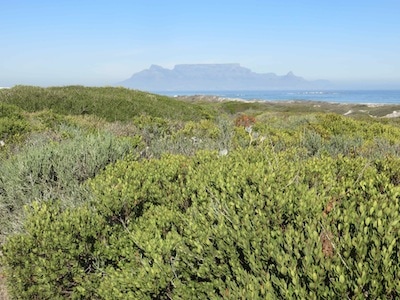 Euclea racemosa and other bushes growing on the seashore north of Cape Town, and showing typical shaping by the wind.
Euclea racemosa and other bushes growing on the seashore north of Cape Town, and showing typical shaping by the wind.Information on our local plants,
a two edged sword !
Euclea racemosa has a wide distribution across Africa, and thus many names and manifold uses. However in addition to all this, it performs a role in ecology at the Cape that is attention worthy and makes it a very special plant that should be more widely planted and conserved locally.
An internet search for information on Euclea racemosa brought results which were disappointing compared to some other plants. I found most sources on the thin side, either comprising just a few lines, or a bare botanical description without other detail. I decided to write a fat article, compiling everything I could find.
If anyone knows of additional information I would love to give references to your material. I love this plant, and many other African forest plants, and would like to promote their use in gardens and agroforestry over exotic vegetation in order to protect our biodiversity on this continent. For that to happen, information and education are key.
The lack of information and exposure to our plants is one factor leading to their disappearance. The same lack leads to their adoption by people from other lands who have more resources, while locals miss out. All the ideas I mention here for the use of the plant are aimed at local people. Please think of them if you make use of our plants. There are many ways to start collaborative projects which bring benefit to local people and yourself and will improve the standing of your products in an international fair trade arena.
Distribution of Euclea racemosa
Euclea racemosa is native to the eastern side of Africa from the land of the pyramids in the north to Africa's southernmost tip, including some of central Africa and extending eastwards off the continent. It is thus found in the Western Cape, South Africa, on South Africa's south and east coast, and in the Comoro Islands, Djibouti, Egypt, Eritrea, Ethiopia, Kenya, Malawi, Mozambique, Oman, Rwanda, Somalia, Sudan, Swaziland, Tanzania, Uganda, Yemen, Zambia, Zimbabwe and Zaire (Kew Science).
Typical habitat of Euclea racemosa
Euclea racemosa is found in coastal thickets and coastal forests (Fernkloof Nature reserve), dune scrub and low coastal forest, mostly on the forest margins (Platbos), in most regions at 1000 to 2400 meters in dry woodland, bushland, riverine forest, and marginal arid areas in both the dry and the moist and wet Kolla and Weyna Dega agroclimatic zones (World Agro Forestry). These latter terms are used in Ethiopia in their multifactorial agricultural zonation system. Interestingly, at the Cape it occurs right on the sea, in the dunes, not just above 1000 meters as in Ethiopia.
Species and subspecies
Euclea
racemosa belongs to the order Ericales, and Family Ebenaceae
(Wikipedia). The genus Euclea has 20 species. All are evergreen trees
and shrubs native to Africa, the Comores and Arabia (Sensagent
dictionary). E. racemosa has several subspecies.
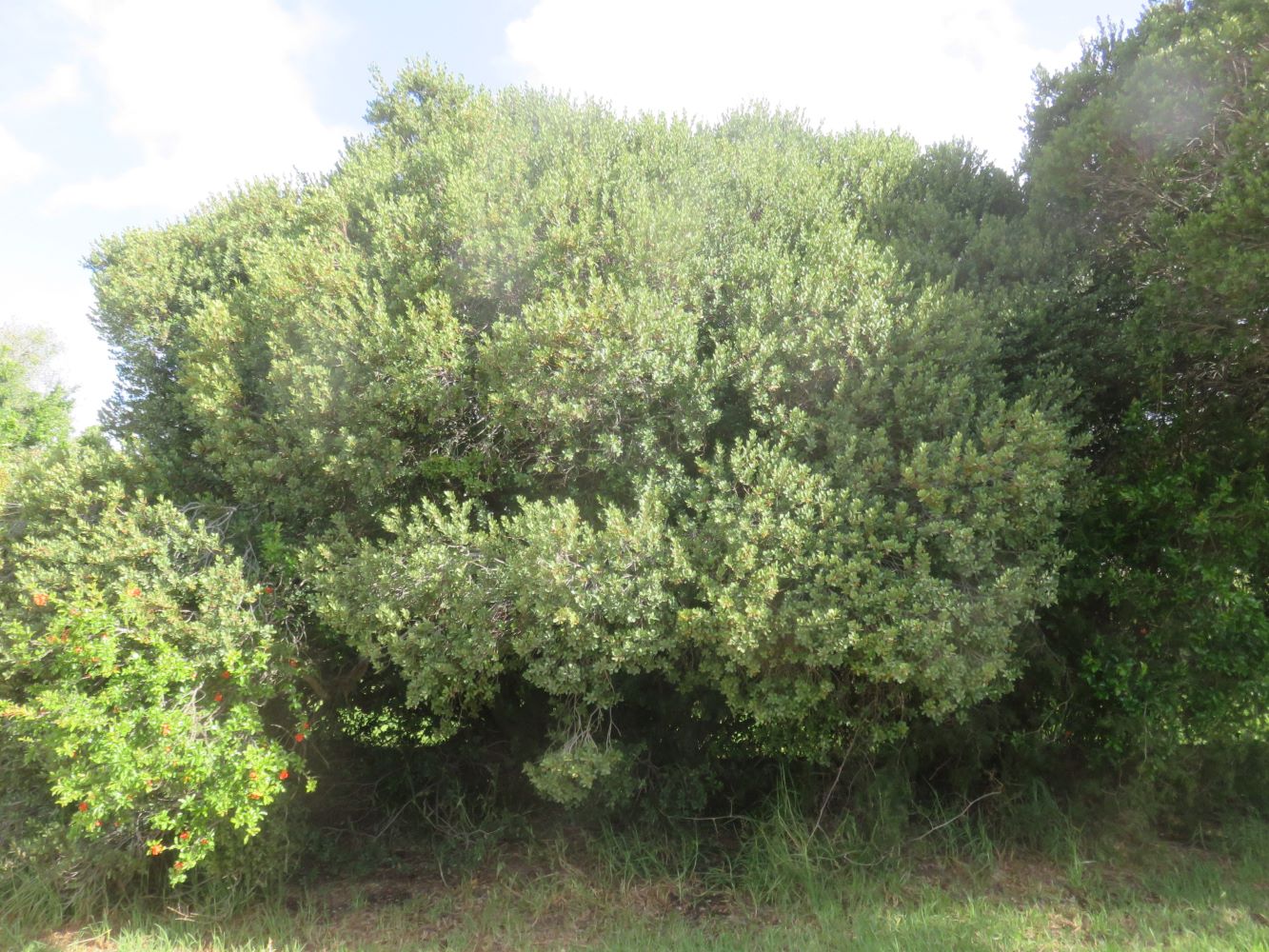 Euclea racemosa growing in full sun. It is growing along a seasonal stream. The soil is sandy with clay banks nearby on the southern slopes of the Tygerberg, Cape Province.
Euclea racemosa growing in full sun. It is growing along a seasonal stream. The soil is sandy with clay banks nearby on the southern slopes of the Tygerberg, Cape Province.Euclea racemosa subsp. bernardii, and racemosa are found only in the Cape Province of South Africa with its winter rainfall summer drought climate. Subspecies E. racemosa daphnoides is found in the Cape Province up the south and east coast to Swaziland and Mpumalanga, and E. racemosa subsp. macrophylla from the Cape and as far as Kwazulu Natal. E. racemosa subsp. sinuata is found from KZN to Mozambique, and subsp. zuluensis is found in KZN, Mozambique and also Swaziland. These are areas with highly variable climate from arid to subtropical. E. racemosa schimperi is recorded in most of the rest of the range of the species (Wikipedia). That is a huge area. I suspect that this is a South African survey and there may be a lot more diversity over the rest of its range that remains to be recorded scientifically.
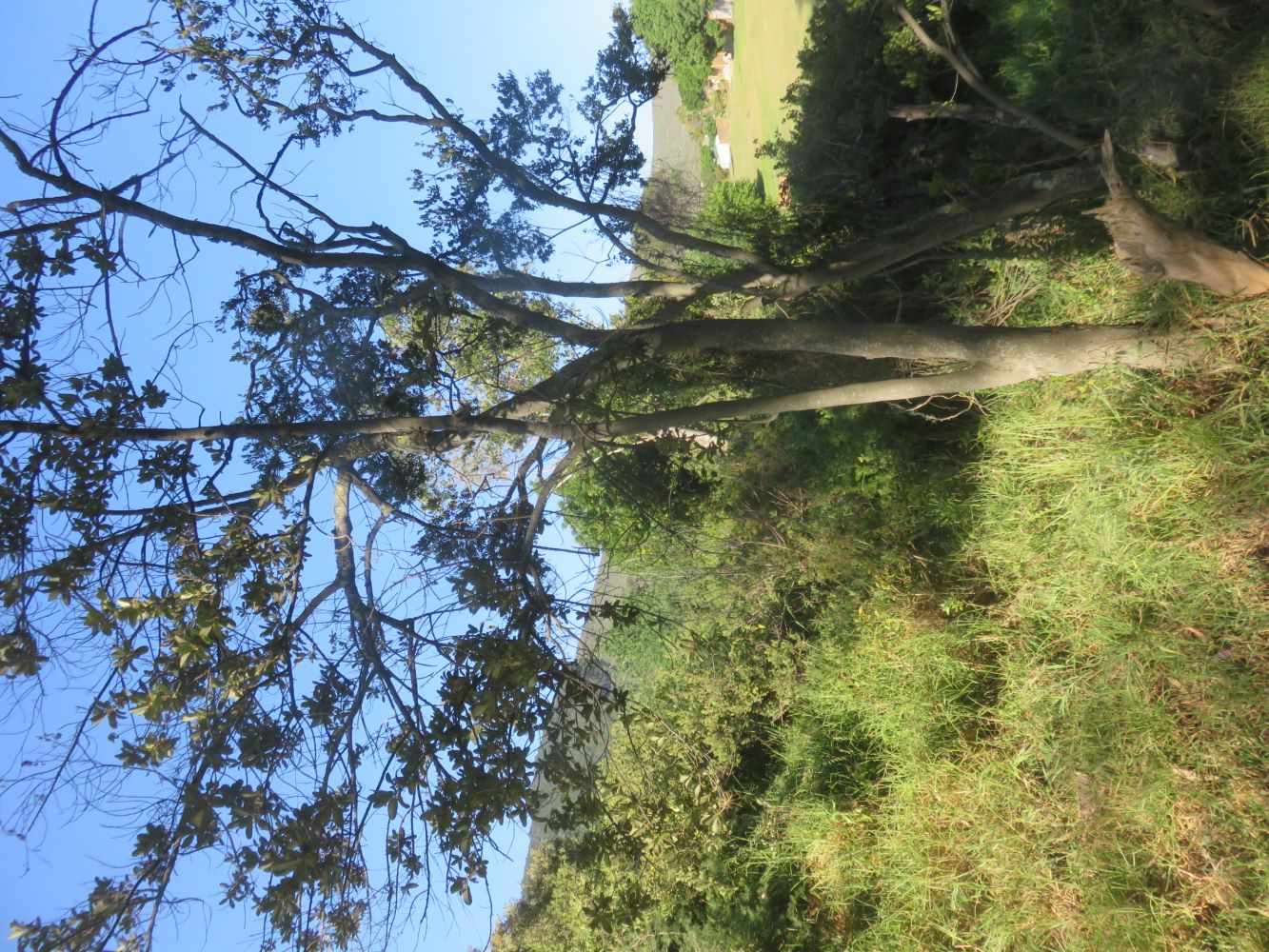 Euclea racemosa growing close to a seasonal stream on the north edge of a grove of tall Eucalyptus trees, at the foot of a clay bank.
Euclea racemosa growing close to a seasonal stream on the north edge of a grove of tall Eucalyptus trees, at the foot of a clay bank.Size and habit of Euclea racemosa
Euclea racemosa's wide distribution leads to the adaption to diverse habitats and quite a bit of genetic variation. I think this is why descriptions across the continent vary. It is a small to medium sized single stemmed evergreen tree or multi-stemmed shrub (Tropical plants database). Its height seems to depend on the habitat, being 2.5 m tall in coastal thickets and up to 6m in coastal forests (Fernkloof ) and has been recorded reaching a height of 12 m (Tropical plants database and Kew Science). The subspecies E.schimperi is usually 3-4 m in height (World Agroforestry). I have seen E. racemosa 6 m tall, and very spindly in the shade of large gums, but forming a dense 4m high hemispherical umbrella which reaches down to the ground in full sun. It is trimmed by the wind into sloping flat pillows with numerous stems in the dunes.
The foliage of Euclea racemosa
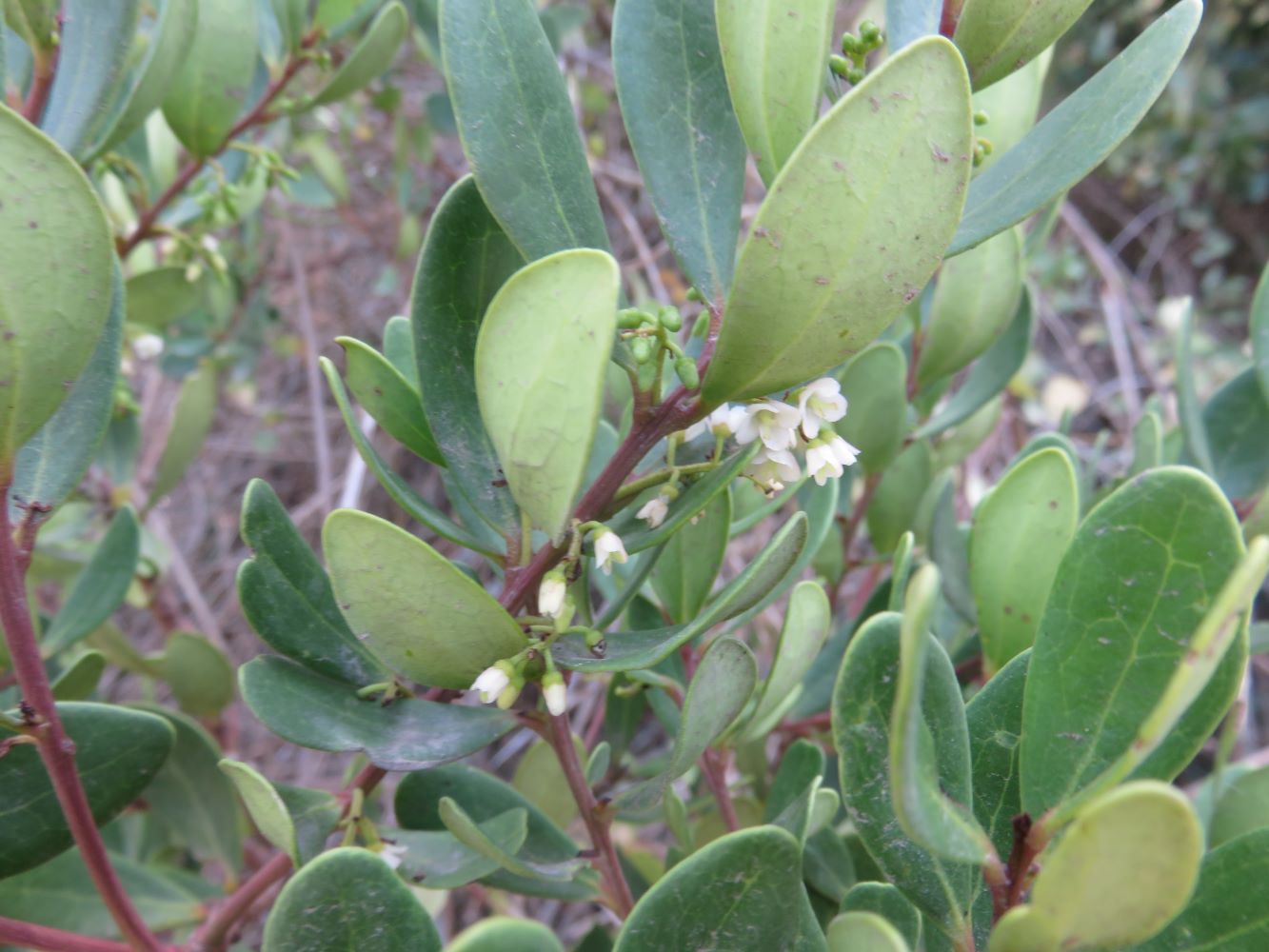 Euclea racemosa foliage and flowers.
Euclea racemosa foliage and flowers.E. racemosa has exceptionally dense leathery foliage (Wikipedia). The leaves are shiny and dark green above and hairless and dull and pale below, forming an elongated oval, about 5cm in length, with a maximum of 11 x 4 cm (Kew Science) with a rounded tip, narrowing to the base (World Agroforestry). The thickish margins are rolled under. The secondary veins are more prominent on the upper surface and can have pink coloration. Tertiary veins are indistinct. (Kew Science). The leaf petiole is less than 1/3rd of a cm, and has characteristic reddish color (Fernkloof).
The young shoots are hairless (glabrous). The arrangement of leaves on the stem is varied: either alternate, subopposite or opposite, sometimes even in whorls (Kew Science).
E. racemosa bark
E. racemosa has slender trunks with rough grey bark (Platbos), or grey-black and rather smooth (World Agroforestry).
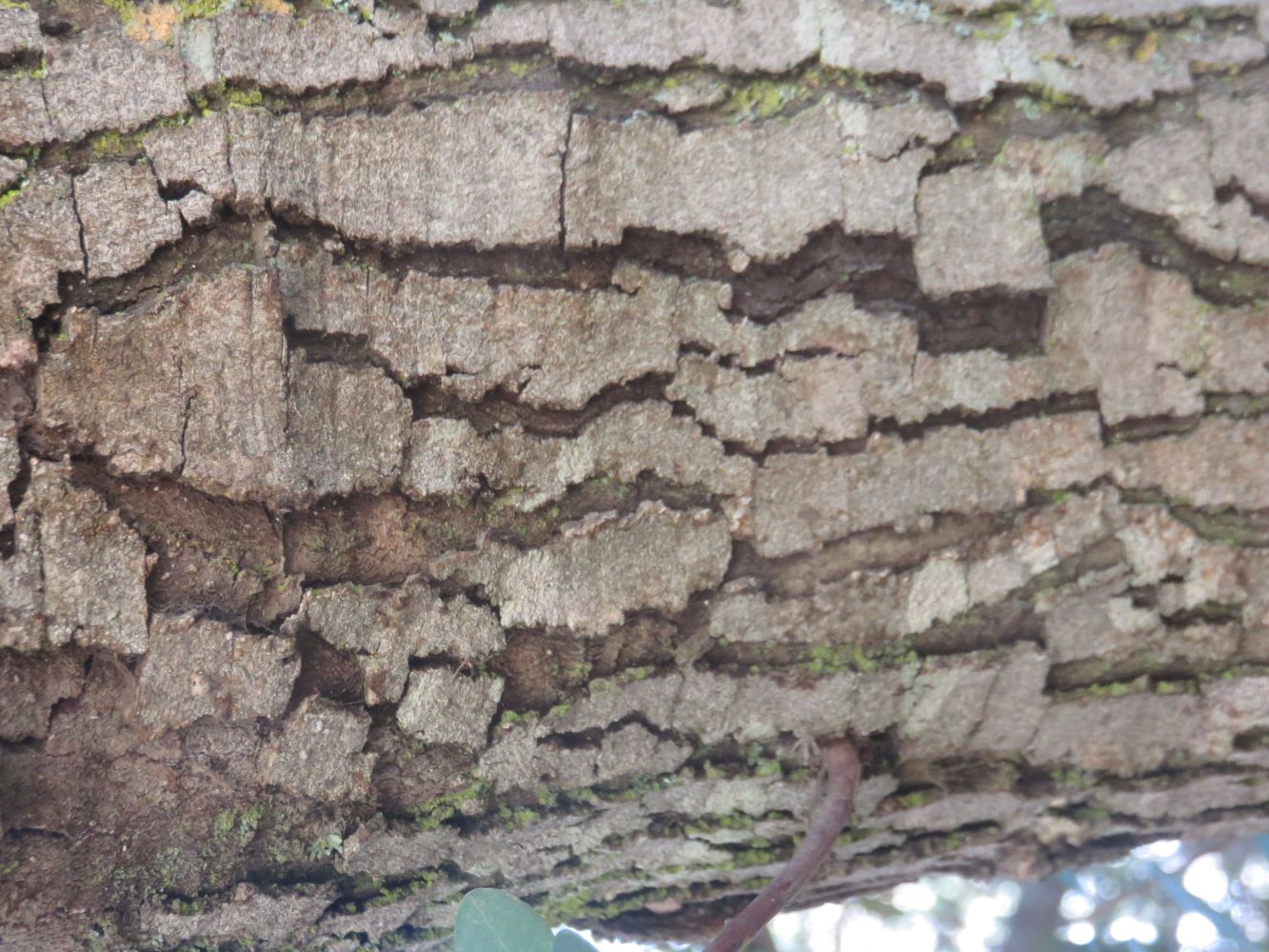 Euclea racemosa bark on an old tree in Cape Town.
Euclea racemosa bark on an old tree in Cape Town.Flowers and fruit
The flowers of E. racemosa are born in short sprays up to 8cm in length beside the leaves (World Agroforestry). In the Cape the sprays are maximally 4cm and drooping (Fernkloof). In yet another description the inflorescence is 15-50mm long, unbranched, with hairless main stem (axis or rachis) (Kew Science).
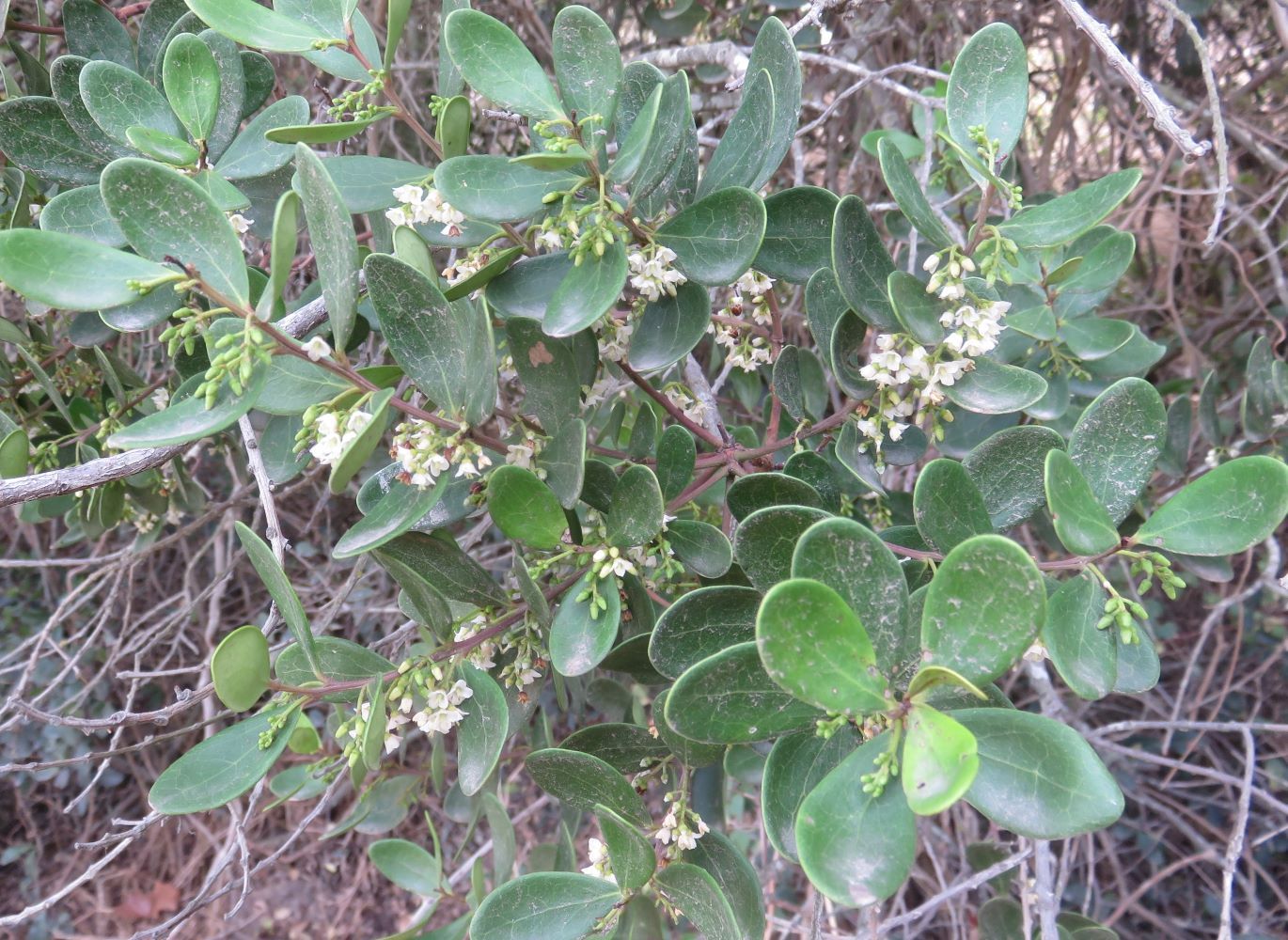 This tree bears only male Euclea racemosa flowers.
This tree bears only male Euclea racemosa flowers.The flowers are rather tiny, creamy white in color and sweet scented, and have a saucer-shaped, shallowly lobed or toothed calyx, with minute hairs on the shallowly lobed or toothed margin. The corolla is lobed only in the upper half, is smooth or sparsely bristled on the middle of the lobes. In another description, the flower is smooth (glabrous) and deeply lobed (Fernkloof). Female flowers are much smaller than the male, with the ovary either smooth or covered with rough hairs. Male flowers are up to 5mm long, the calyx 2mm. They bear 10-20 stamens, mostly in pairs, with filaments up to 1.3mm long and anthers up to 3mm long, which are bristly near the tips (Kew Science).
The plant is dioecious (Fernkloof, Tropical plants database, Wikipedia) requiring both male and female plants to produce fruit. The fruit attract many birds (Platbos and Wikipedia) as well as honey bees (Platbos).
E. racemosa bears flowers in December to June (Fernkloof ) or December to March (Platbos). The plants I know are flowering in February and March. In the southern peninsula they are said to flower earlier.
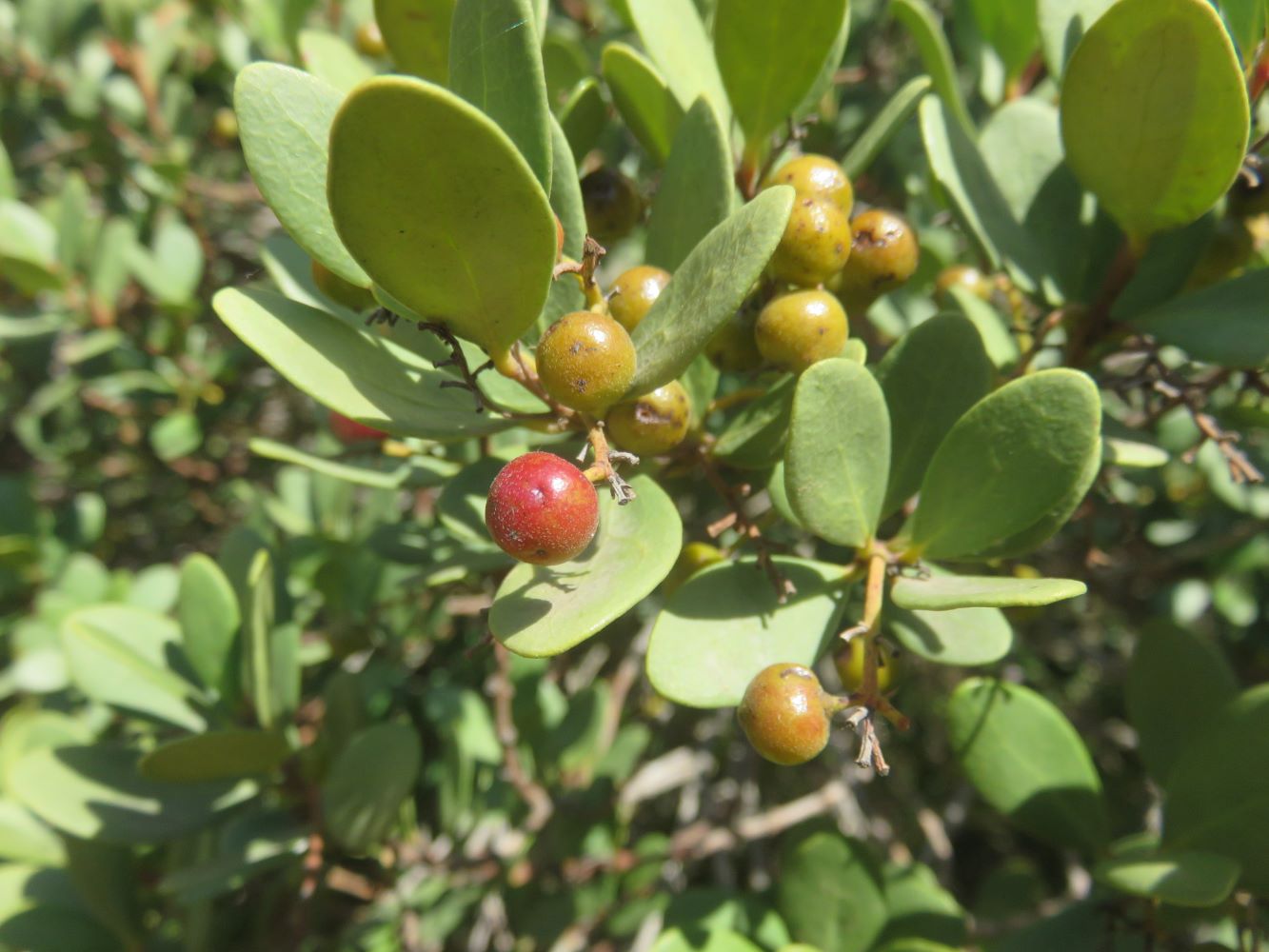 This tree bears female reproductive parts, including fruit. These are typically seen in a range of colors showing different ripeness.
This tree bears female reproductive parts, including fruit. These are typically seen in a range of colors showing different ripeness.The fruit is 6-8mm in diameter (Kew Science), green and ripening to purple-black, giving it characteristic multicolored berries in red, purple and black (Wikipedia). They are edible, with thin flesh around a double seed (World Agroforestry).
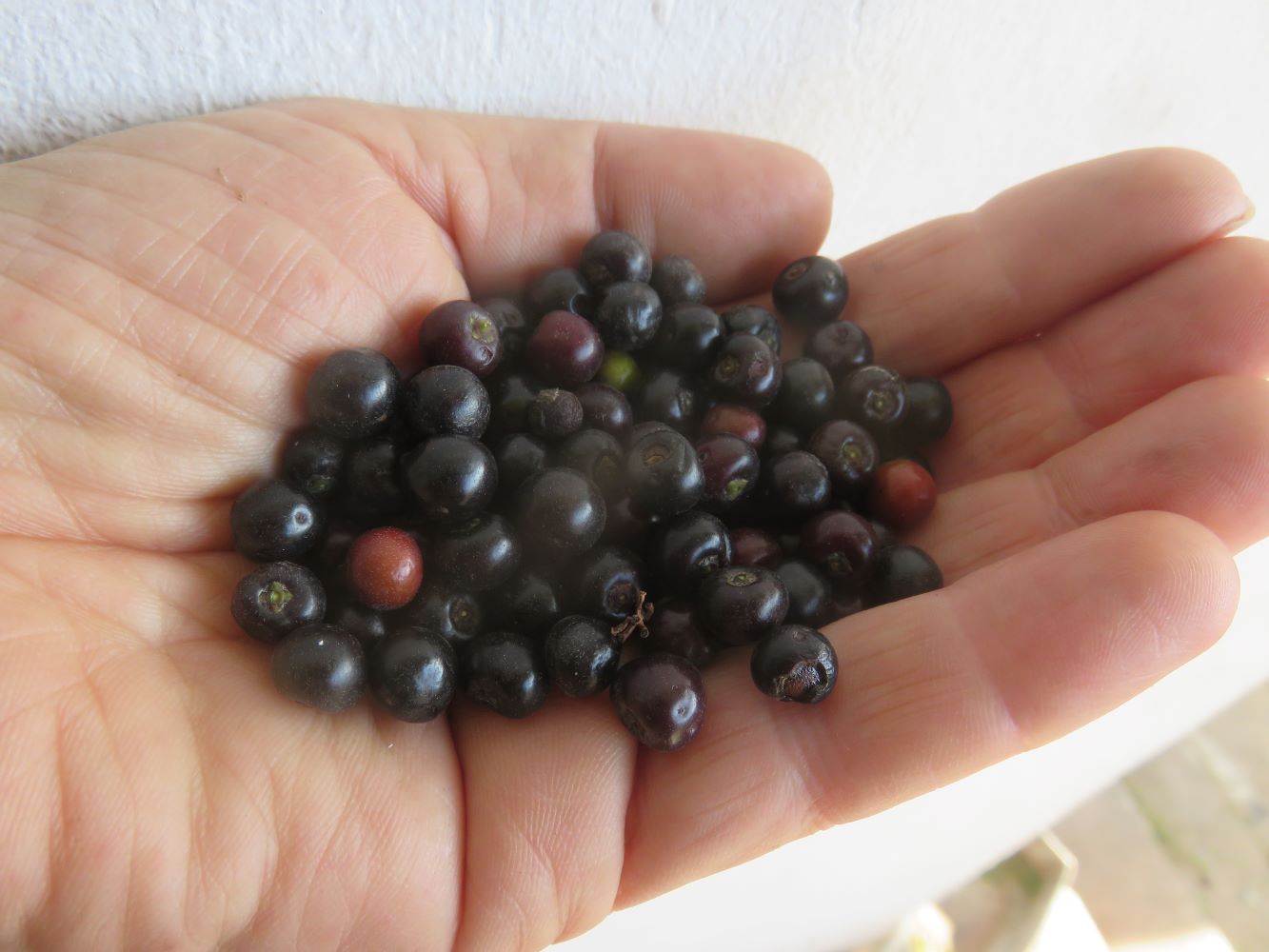 Ripe Euclea racemosa berries
Ripe Euclea racemosa berriesIn my experience the berries are sweet, with a slightly insipid black berry flavor, like a table grape and slightly tannic. I found only single round seeds in the fruit. Perhaps they have an outer skin which peels off to reveal two seeds. This would explain why after sowing the seeds I often got two seedlings coming up.
Naming
The common name of the plant in South Africa is variously spelled gwarri (Wikipedia), gwarrie, guarri and guarrie (Wikipedia). It is just variation in the representation of a similar sound, in a language which has only recently been written down, or not, as the case may be.
Wikipedia
claims the true spelling in our native Khoe language is 'gwarri' and
the common spelling is 'guarrie'. I would love to know which Khoe language they are referring to, and where they saw the correct spelling discussed, because the only sizable Khoekhoegowab dictionary is Haacke-Eiseb 2002 and there is no 'w' in that orthography, whereas the spelling 'guarri' is possible. The 'ie' ending is typical of Afrikaans and that is where they may have got their wires crossed. There is also no mention of the plant in whatever form it is spelled in the dictionary. That is to be expected, it does not occur in Namibia, where the dictionary was created.
The Platbos website claims guarrie is a Khoesan word meaning bush or tree. This I cannot disprove, and it seems, they cannot prove. There is no similar word let alone one with this meaning in Haacke-Eiseb (2002). None of the claims about the origin of the name are accompanied by a reference to where they got their information. Having said this, I will continue as if all these claims are partially true, because it's likely to be a Khoe word in origin, as it sounds like a Khoekhoegowab word, and many plant names in Afrikaans do have this origin.
Lets move on to other names of this wonderful and widespread plant. In a paper entitled Ethnobotanical survey in Canhane village, district of Massingir, Mozambique: medicinal plants and traditional knowledge (2010) by Ana Ribeiro, Maria M. Romeiras, Joao Tavares, Maria T. Faria. The following common names are given: mulala, nhlangulo, bush guarri, glossy guarrie, river guarri.
The Latin species name racemosa is derived from the Latin racemus, a bunch or cluster of grapes. It is a reference to the appearance of the fruit cluster (Fernkloof ).
The use of Euclea racemosa
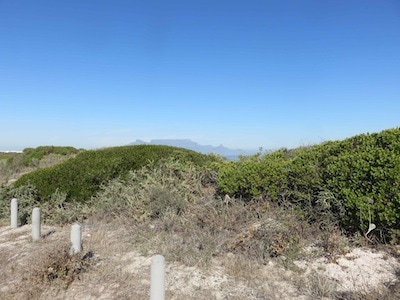 Bushes holding the dunes and shaped by the wind.
Bushes holding the dunes and shaped by the wind.E. racemosa in landscaping
The tree is exceptionally attractive in my view. It is used as an ornamental. Its leathery foliage is very dense, ideal for hedges (Wikipedia) and it is thus also used as a live fence for boundary marking (World Agroforestry) probably in Ethiopia based on the source. In addition it is suited to coastal gardens (Platbos) which can be difficult, due to the salt laden air.
The guarri in restoration
E.racemosa is used as a pioneer species in soil conservation and reforestation projects (Tropical Plants Database).
My
own interest in the dune Gwarrie is based on what I observed in
coastal hikes north of Milnerton, Cape Town. It took a me a while to
identify the low trees that I observed growing in the dunes. I was
greatly helped by local botanists on the public platform iNaturalist
in so doing, where you can see my records and those
of many other keen citizen scientists.
I noticed that this tree is a very important pioneer in establishing dune vegetation. I think it is the most key species in that role, but I'm not an ecologist or botanist. It keeps growing up through the sand dunes that form around it from the action of the wind, until it can stand clear of the sand. Then it is cropped by the wind into gentle green pillows that echo the landscape of waves and dunes. This combination of sloping green cushions and white sand is so beautiful I don't know why it isn't part of our local garden design aesthetics.
My mother (a botanical activist) described this type of vegetation as a Liliputian forest, with a low canopy, and ferns and vines and other levels of forest vegetation below. If the guarri can support other plants in the wild, it can do so in a food forest or agroforestry situation.
I suspect that Euclea was probably very dominant in the vegetation of the Cape Flats once, and that all the Euclea was removed during the early colonial era, as it is an excellent firewood, and the removal of the dune vegetation for firewood was recorded, as was the problem it created. Removal released the sand and shifting dunes became a problem. Australian wattles were imported by the British to hold the dunes. These in turn became highly invasive and created problems as they suppressed local vegetation, and impacted on the hydrology of the landscape, reducing the water flow in rivers.
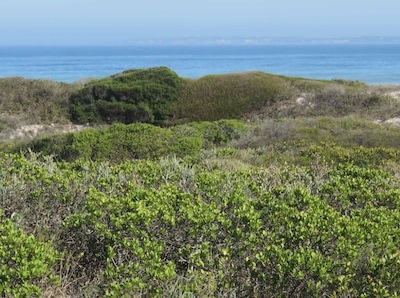 Bushes sculpted by the strong winds off the southern oceans.
Bushes sculpted by the strong winds off the southern oceans.E. racemosa is ideal for reforesting areas of Cape Town where sand is exposed after urban development. As a pioneer with its own edible fruit it would make a tough backbone for food forests in the sandy areas that used to be covered by ocean between Table Mountain and the surrounding mountain ranges, on the Cape Flats. It could be used in places which are hard to irrigate, where our new revolution for verge vegetable plantings cannot reach. There it can begin to create the sheltered micro-climate in which other more productive food plants thrive.
This
would provide many ecosystem benefits such as carbon
sequestration, healthy hydrology and soil, as well as
services to the environment like the maintenance of insect diversity and
services to the community in terms of wind protection for gardens, high
anti oxidant wild berries, firewood and more.
Guarri timber
Several Eucleas are used as hardwood timber producing hard, dark heartwood similar to ebony (Sensagent dictionary). The timber of E. racemosa itself is fine grained and heavy, with red to purple hue (Platbos). The wood is sometimes employed by wheelwrights and turners, and also serves very well for wooden screws (Tropical plants database) and making farming implements (Sensagent dictionary). It is also used as roofing material, the branches used as tooth brushes (Tropical plants database). It burns very well and so is chiefly used as fuel. It is harvested wild for all these purposes, but could be grown in a plantation or coppicing system to save the dune forests.
The fruit
E. racemosa fruit is harvested through the extent of its range for food (World Agroforestry), mostly from the wild (Tropical Plants Database). The berries are used locally in South Africa to make "Guarrie vinegar" according to Wikipedia. I have never seen or tasted this vinegar. It must be very good.
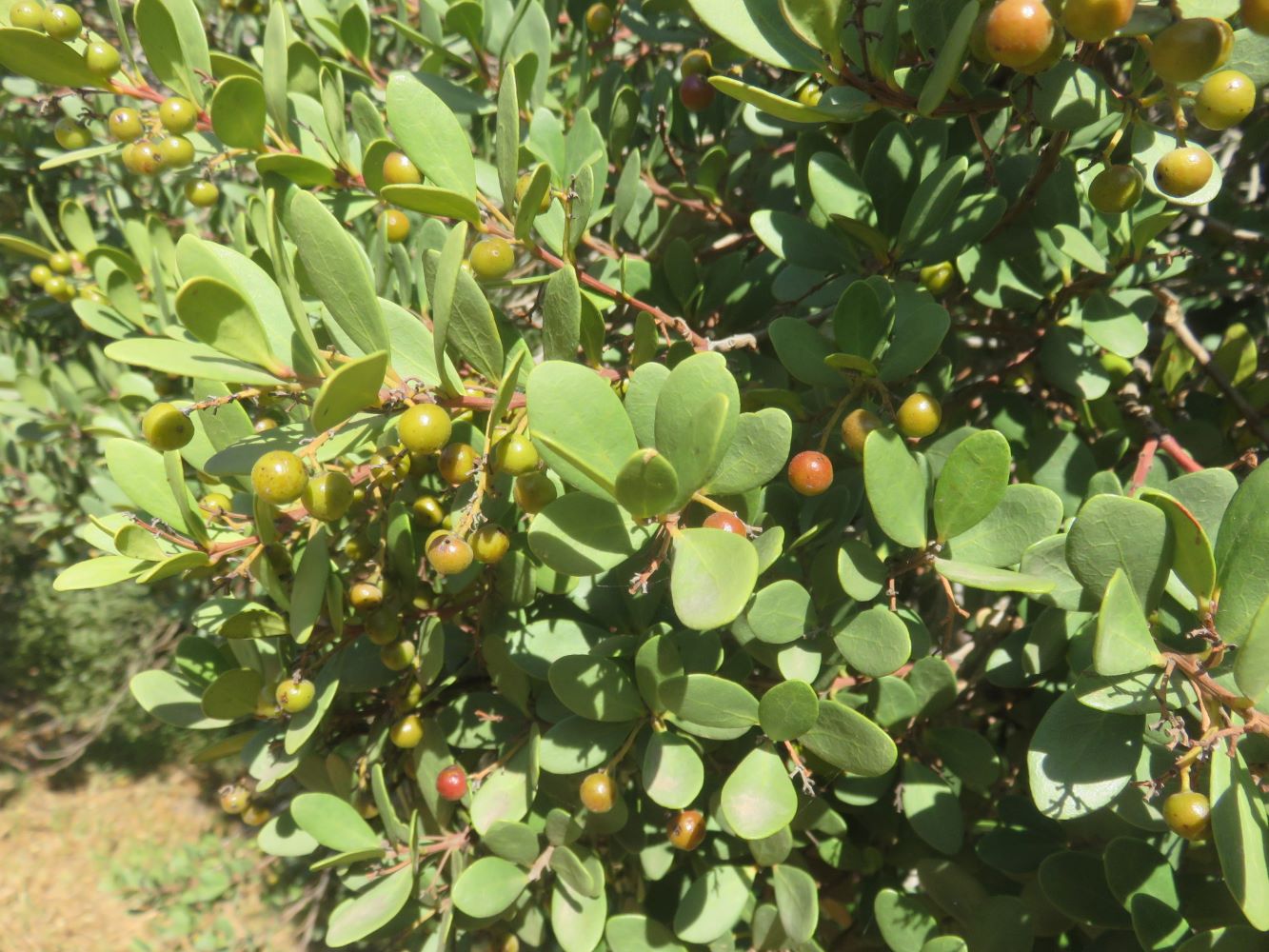 E.racemosa fruit branches
E.racemosa fruit branchesGuarri extracts
A black dye can be obtained from the roots (World Agroforestry and Tropical Plants Database). This could be useful when oil runs out and the demand for organic clothing increases sufficiently. The roots are mainly harvested from the wild for medicine (Tropical plants database) used as a purgative, for treating caries and toothache (Tropical plants database). It is taken orally, by chewing in Mozambique. Roots are also used for wounds, applied topically after peeling and grinding. The stem is used for wounds as a bath after cutting and steeping in water (Ribeiro et al. 2010).
It would be preferable for the roots to remain in the ground from an environmental point of view. As the tree performs well in a coppicing regime, one could harvest the branches more sustainably.
E. racemosa contains pentacyclic triterpenoids (Sensagent dictionary). These are biologically active phytochemicals with properties that are anti-inflammatory, hepatoprotective, anti-hypertensive, antiulcerogenic and anti-tumor (NCBI).
The
use of Euclea racemosa in Africa is just part of a bigger picture
showing how much we need to maintain biodiversity to serve needs on
the continent. The area where the study was done in Mozambique is an important repository of biological diversity. They
found that 90% of the population make use of this plant diversity for
housing, food, energy and health. 15% of the 5500 species found there
are used for medicine (Ribeiro et al. 2010).
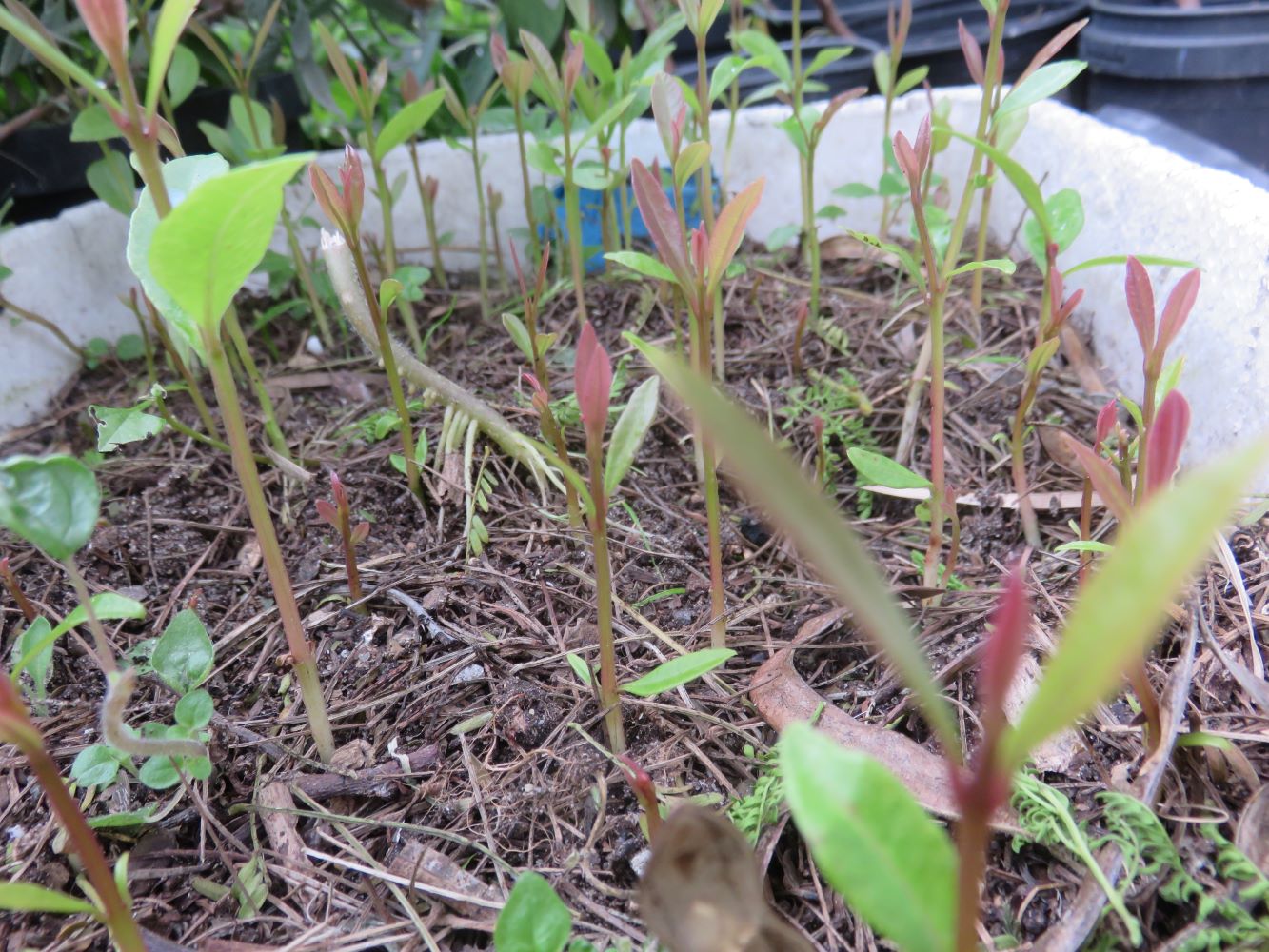 E. racemosa shortly after germination
E. racemosa shortly after germinationHorticulture notes
E. racemosa can be grown from seeds, layering and cuttings. It also produces root suckers. The seeds often fail to germinate as they are parasitized by a type of fly larva (Platbos). I had no problem with germination. It was really good. This may be due to the different localities and scale of our nurseries, and that I didn't use seeds which had fallen to the ground. As I can substantiate, no pre-treatment of the seed is needed (Tropical plants database). Apparently the seed stores well in air tight containers at room temperature (Tropical plants database) and there are 18000-20000 seeds per kg (World Agro Forestry). As said previously the plant can be coppiced, and responds well to trimming (Tropical plants database).
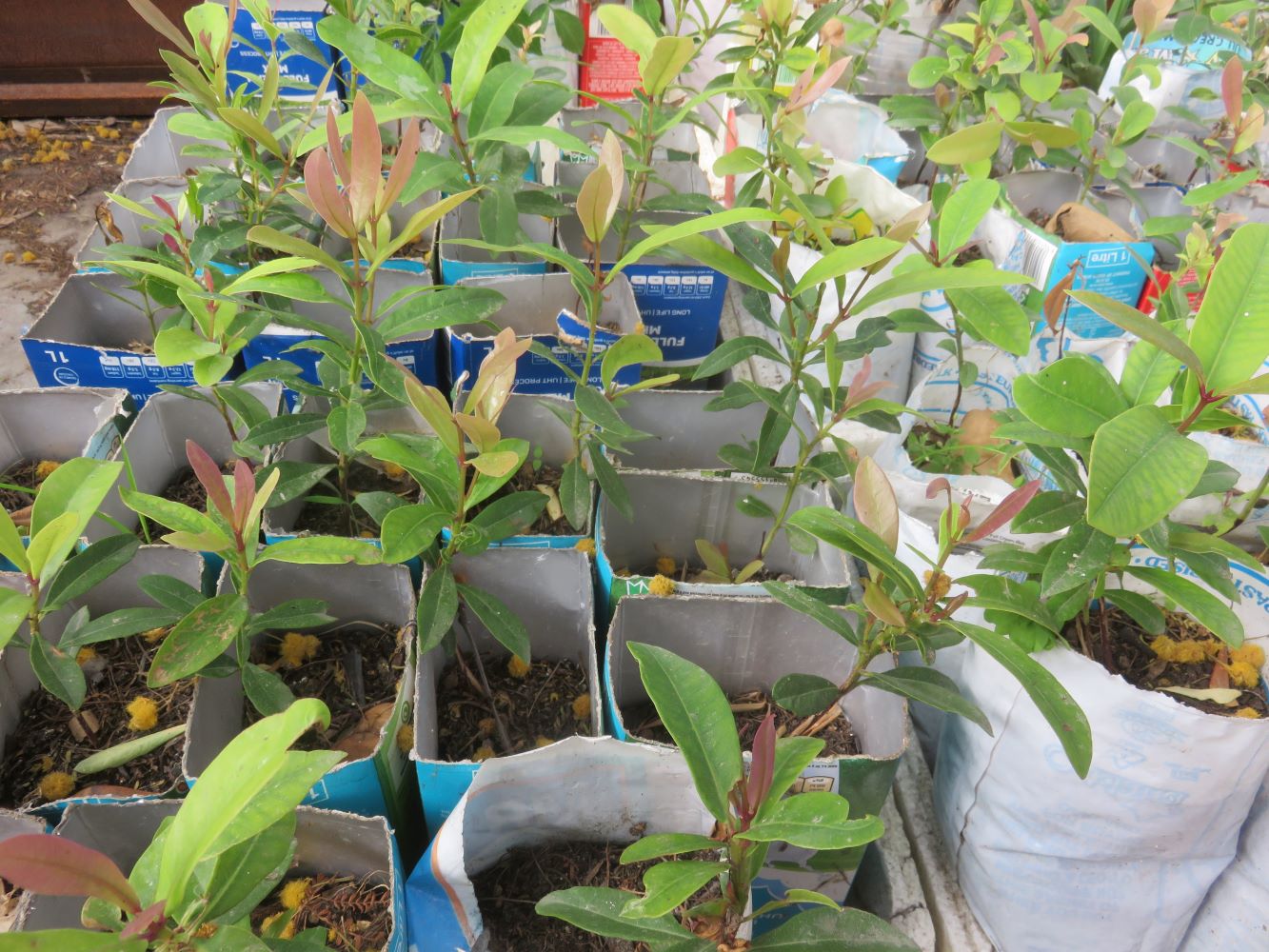 The seedlings moved from shade house to open sky, semi shade.
The seedlings moved from shade house to open sky, semi shade.The outcome of my propagation attempts
As you can see I had really good germination. However, from the stage the seedlings are at in the photograph above, everything went down hill, and one by one I lost all of my one hundred seedlings. The leaves would slowly go dull, then yellow and curl up. Some of the stems started to re-sprout with numerous small red buds, but none of them made it. I have never had such bad luck with other African fruit trees with wide distribution. Harpephyllum caffrum and Dovyalis caffra come excellently from seed and grow on without problems.
My Euclea racesmosa cuttings also failed. The were taken from some water sprouts off a tree, and perhaps the sprouting was due to a pathogen in the tree itself. Carissa bispinosa I have grown from pencil thick cuttings successfully.
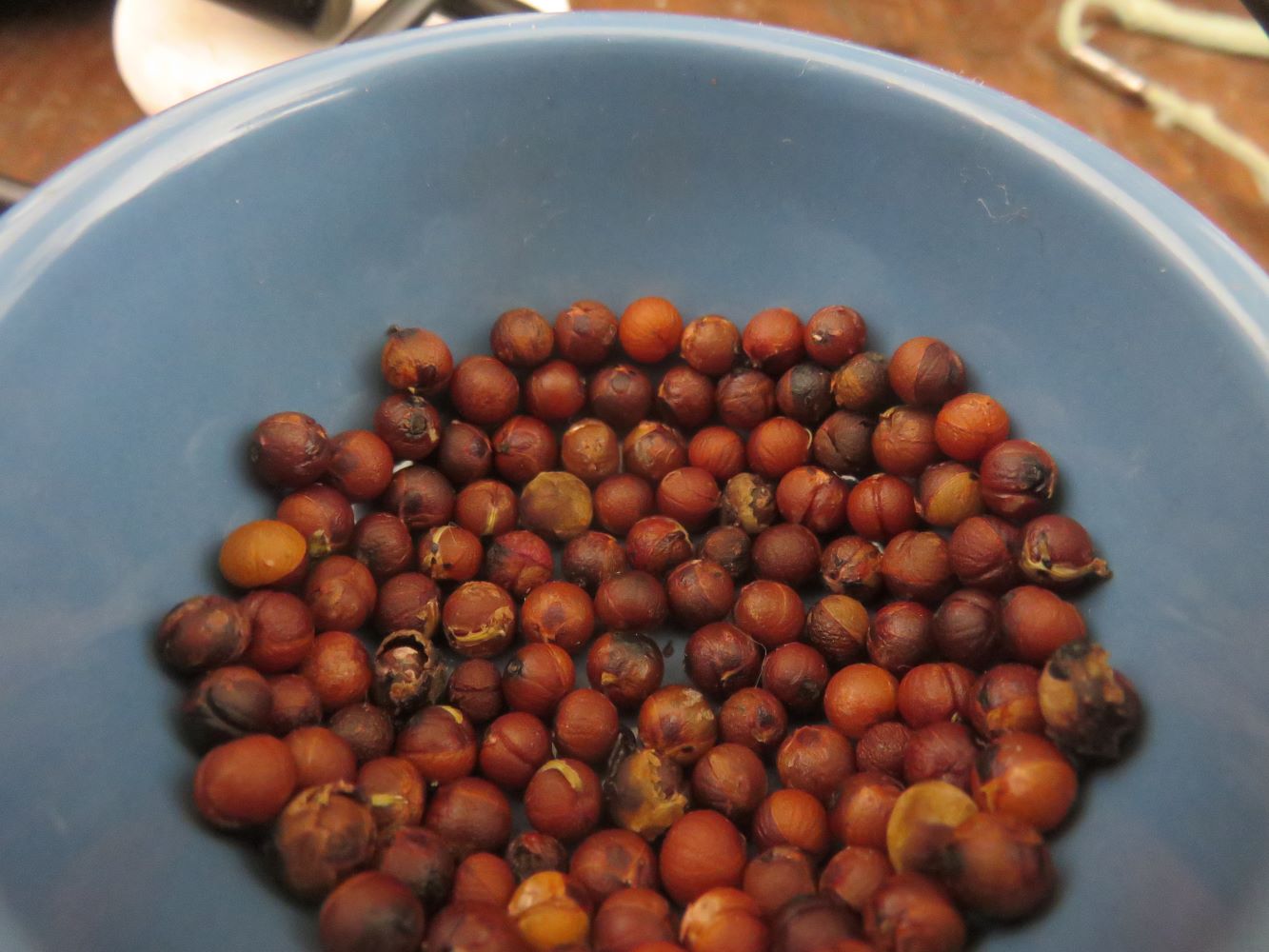 Fresh Euclea racemosa seed, summer 2021.
Fresh Euclea racemosa seed, summer 2021.Trying again
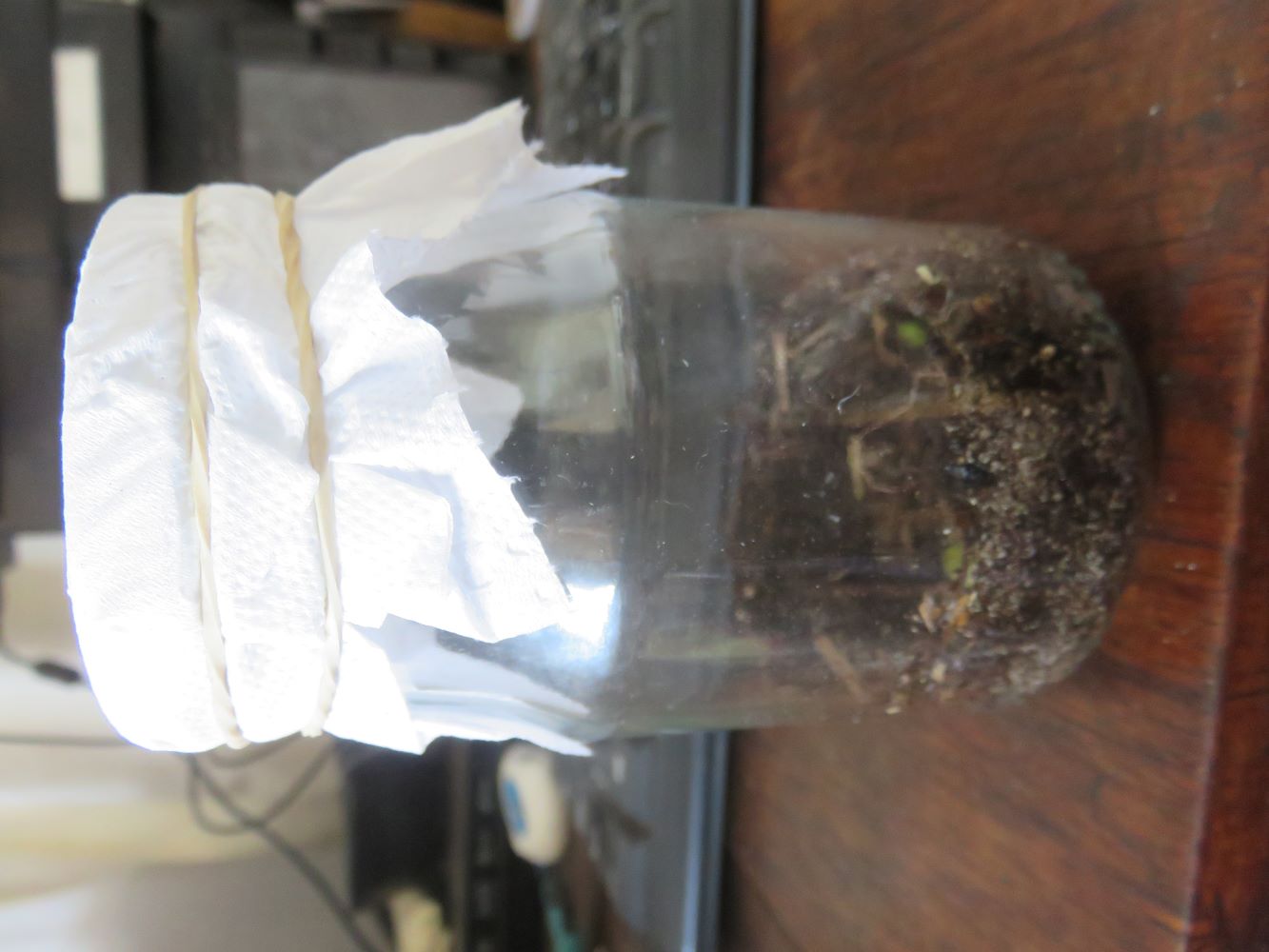 The jar in which I hope to see the maggot pupate and emerge as an adult.
The jar in which I hope to see the maggot pupate and emerge as an adult.This year I collected Euclea racemosa fruit again. We have had very exceptional, consistent rains for summer. But the fruit were not juicy and sweet like last time, but tannic and woody.
I ate away doggedly and cleaned up a tablespoon full of seed. As you can see above many of them are splitting with a white radicle coming out, so I will sow them soon. The little bowl of seed was on my desk when I noticed movement. I found a small pencil-lead-sized maggot crawling out of one of the seeds, which had become hollow. Perhaps this is the maggot that the Greenpop horticulturists have had problems with. I have put it into a jar with some compost and I will wait for it to pupate and then emerge from the pupa and see what comes out. I'm basing this strategy and expectation on the life cycle of fruit flies which crawl out of the fruit when they are ready to pupate and bury themselves in the ground where they undergo metamorphosis.
The maggot's skin is very textured, almost like a closed pine cone and it has a row of nubs like handles down its sides. It is so small I could only see the texture when I magnified the photograph.
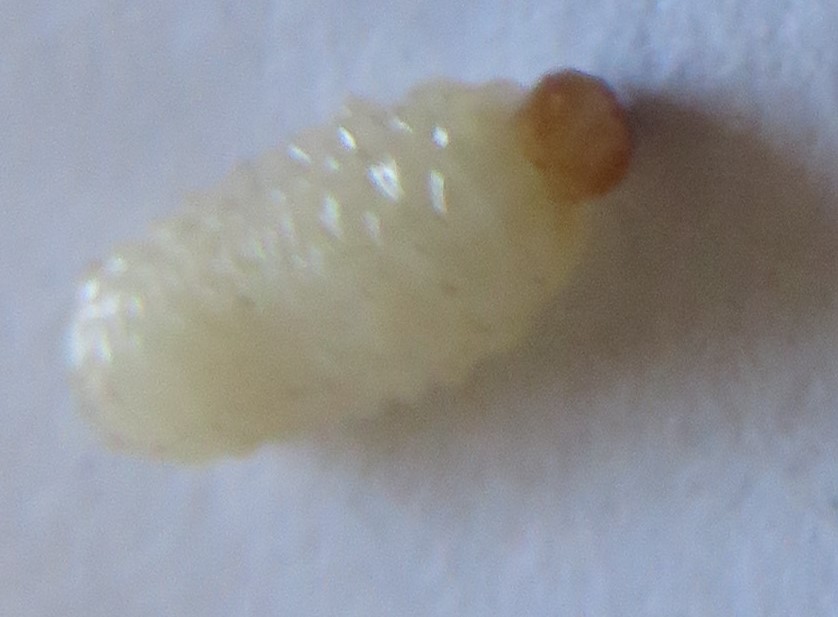 Is this the maggot that makes Euclea racemosa germination problematic ? See its pine cone patterning.
Is this the maggot that makes Euclea racemosa germination problematic ? See its pine cone patterning.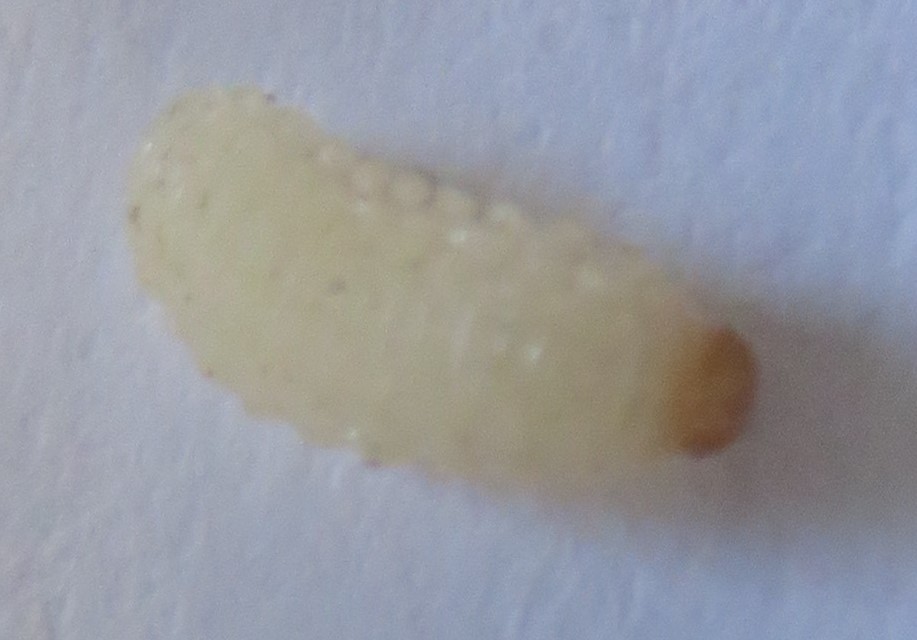 The rows of side nubs
The rows of side nubs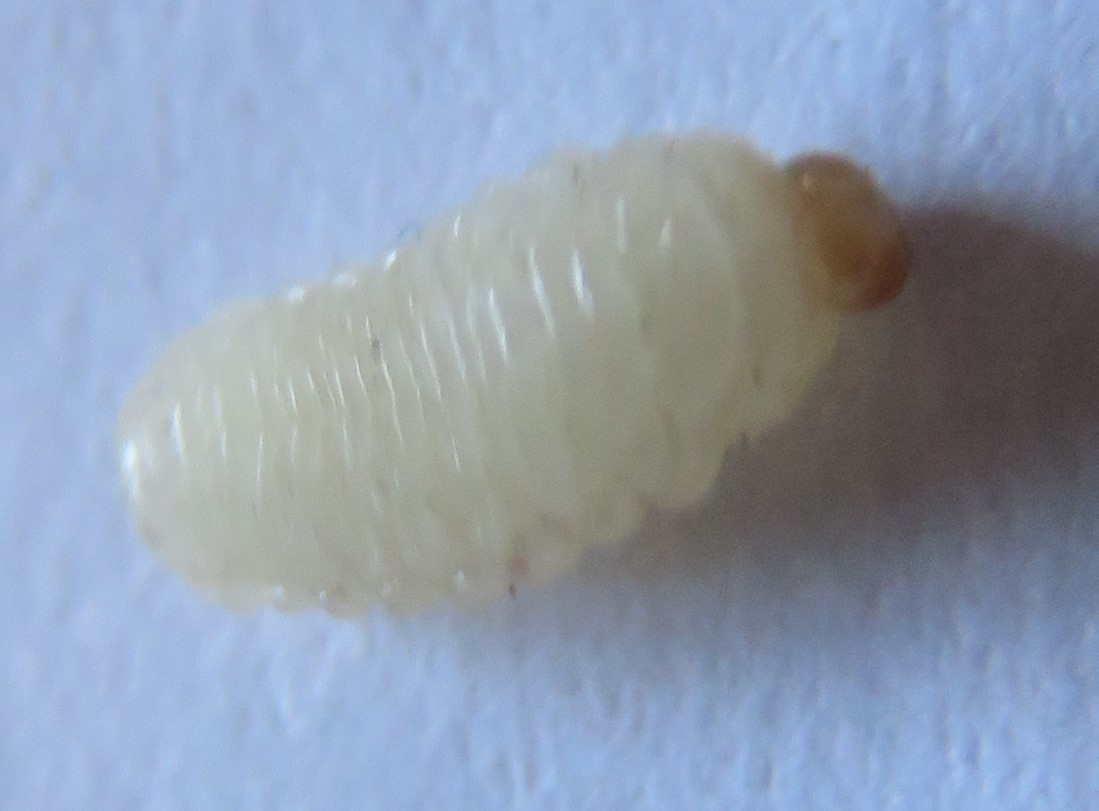 In this light it looks more 'ribbed'.
In this light it looks more 'ribbed'.References
Fernkloof (The Fernkloof Nature Reserve website). https://www.fernkloof.org.za/index.php/all-plants/plant-families/item/euclea-racemosa- subsp-racemosa
Haacke W.H.G, Eiseb E. 2002. The Khoekhoegowab dictionary with an English Khoekhoegowab Index. Windhoek: Gamsberg Macmillan.
iNaturalist https://www.inaturalist.org/observations/34697953
Kew Science http://www.plantsoftheworldonline.org/taxon/urn:lsid:ipni.org:names:323337-1
NCBI https://www.ncbi.nlm.nih.gov/pmc/articles/PMC6645347/
Platbos (Platbos Indigenous Forest website) ttp://www.platbos.co.za/african_tree_essence_seaguarrie.html https://www.platbos.co.za/indigenous_sea_guarri.html
Ribeiro et al. (2010) Ethnobotanical survey in Canhane village, district of Massingir, Mozambique: medicinal plants and traditional knowledge. Ana Ribeiro, Maria M. Romeiras, João Tavares, Maria T. Faria. Journal of Ethnobiology and Ethnomedicine volume 6, Article number: 33 (2010) https://link.springer.com/article/10.1186/1746-4269-6-33
Sensagent dictionary http://dictionary.sensagent.com/euclea/en-en/
Tropical Plants Database http://tropical.theferns.info/viewtropical.php?id=Euclea%20racemosa Cite as: Tropical Plants Database, Ken Fern. tropical.theferns.info. 2021-02-24. <tropical.theferns.info/viewtropical.php?id=Euclea%20racemosa>
Wikipedia https://en.wikipedia.org/wiki/Euclea_racemosa
World Agroforestry http://apps.worldagroforestry.org/usefultrees/pdflib/Euclea_racemosa_ETH.pdf
------
------
native trees grown from seed and cuttings
------
Harpephyllum caffrum, the anti oxidant bomb.
Restore Nature Newsletter
I've been writing for four years now and I would love to hear from you
Please let me know if you have any questions, comments or stories to share on gardening, permaculture, regenerative agriculture, food forests, natural gardening, do nothing gardening, observations about pests and diseases, foraging, dealing with and using weeds constructively, composting and going offgrid.
What Other Visitors Have Said
Click below to see contributions from other visitors to this page...
Landscape Architect 




I so appreciate your informative description! Your experimentation and curiosity with the seeds, germination, and rearing of the maggot are exciting to …
Thank you! 




Thanks very much for this article, definitely the most detailed one I found after an extensive search online AND through a library of plant books too! …
Mr Patrick Dowling 




Thorough article, thanks Caroline, and interesting. I'm also a big fan of Euclea and feel it's under appreciated. What a splendid small tree if allowed …
SEARCH
Order the Kindle E-book for the SPECIAL PRICE of only
Prices valid till 30.09.2023
Recent Articles
-
garden for life is a blog about saving the earth one garden at a time
Apr 18, 25 01:18 PM
The garden for life blog has short articles on gardening for biodiversity with native plants and regenerating soil for climate amelioration and nutritious food -
Cape Flats Sand Fynbos, Cape Town's most endangered native vegetation!
Apr 18, 25 10:36 AM
Cape Flats Sand Fynbos, a vegetation type found in the super diverse Cape Fynbos region is threatened by Cape Town's urban development and invasive alien plants -
Geography Research Task
Jan 31, 25 11:37 PM
To whom it may concern My name is Tanyaradzwa Madziwa and I am a matric student at Springfield Convent School. As part of our geography syllabus for this
"How to start a profitable worm business on a shoestring budget
Order a printed copy from "Amazon" at the SPECIAL PRICE of only
or a digital version from the "Kindle" store at the SPECIAL PRICE of only
Prices valid till 30.09.2023







